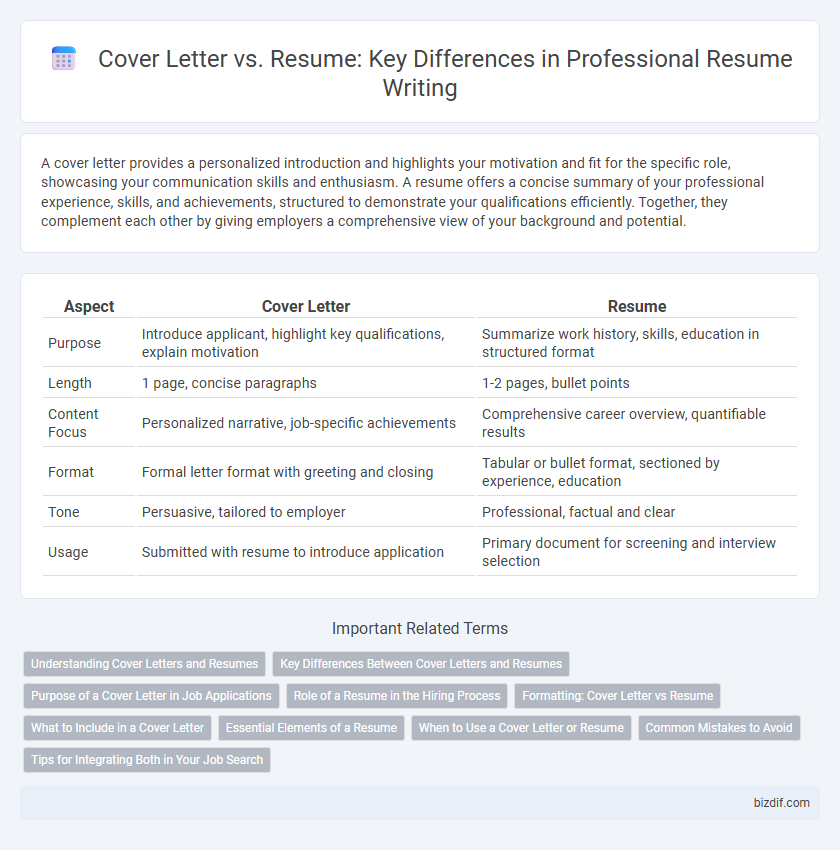A cover letter provides a personalized introduction and highlights your motivation and fit for the specific role, showcasing your communication skills and enthusiasm. A resume offers a concise summary of your professional experience, skills, and achievements, structured to demonstrate your qualifications efficiently. Together, they complement each other by giving employers a comprehensive view of your background and potential.
Table of Comparison
| Aspect | Cover Letter | Resume |
|---|---|---|
| Purpose | Introduce applicant, highlight key qualifications, explain motivation | Summarize work history, skills, education in structured format |
| Length | 1 page, concise paragraphs | 1-2 pages, bullet points |
| Content Focus | Personalized narrative, job-specific achievements | Comprehensive career overview, quantifiable results |
| Format | Formal letter format with greeting and closing | Tabular or bullet format, sectioned by experience, education |
| Tone | Persuasive, tailored to employer | Professional, factual and clear |
| Usage | Submitted with resume to introduce application | Primary document for screening and interview selection |
Understanding Cover Letters and Resumes
Cover letters provide a personalized introduction, highlighting key skills and experiences tailored to the specific job, while resumes offer a concise summary of qualifications, education, and work history. Effective cover letters explain the applicant's motivation and fit for the role, complementing the resume's detailed bullet points. Employers use cover letters to assess communication abilities and enthusiasm, whereas resumes are analyzed for relevant expertise and career progression.
Key Differences Between Cover Letters and Resumes
Cover letters provide a personalized introduction and highlight motivation, while resumes present a structured summary of skills, experience, and education. Cover letters emphasize storytelling and tailored content to address specific job requirements, whereas resumes focus on concise bullet points and quantifiable achievements. The key difference lies in the cover letter's narrative style compared to the resume's factual and data-driven format.
Purpose of a Cover Letter in Job Applications
A cover letter serves as a personalized introduction, highlighting key qualifications and explaining the motivation for applying to a specific position. Unlike a resume which lists skills and experience, the cover letter connects the applicant's background to the employer's needs, showcasing communication skills and cultural fit. Its primary purpose is to demonstrate enthusiasm and provide context that encourages the hiring manager to review the attached resume in detail.
Role of a Resume in the Hiring Process
A resume serves as a concise summary of a candidate's skills, experience, and achievements, acting as the primary document used by hiring managers to screen applicants. It highlights quantifiable career accomplishments and relevant qualifications, ensuring alignment with the job description and company needs. The resume's structured format facilitates quick evaluation of a candidate's suitability for the role, directly influencing progression to the interview stage.
Formatting: Cover Letter vs Resume
Cover letters typically follow a formal business letter format with a header, salutation, body paragraphs, and a closing signature, emphasizing personalized content tailored to the job. Resumes utilize a concise, bullet-point layout with clear section headings such as Experience, Education, and Skills, optimizing readability and scanning by applicant tracking systems (ATS). Precise formatting in resumes includes consistent fonts, margins, and alignment, while cover letters prioritize professional tone and custom messaging aligned with the job description.
What to Include in a Cover Letter
A cover letter should include a personalized introduction, highlighting your enthusiasm for the role and company, as well as a concise summary of relevant skills and experiences that match the job description. Emphasize specific achievements and problem-solving abilities that demonstrate your value, while aligning your career goals with the company's mission. Conclude with a call to action, expressing readiness for an interview and appreciation for the employer's consideration.
Essential Elements of a Resume
A resume highlights essential elements such as contact information, professional summary, work experience, education, and relevant skills tailored to the job description. Unlike a cover letter, it uses concise bullet points and quantifiable achievements to demonstrate qualifications effectively. Including keywords from job postings ensures applicant tracking systems (ATS) recognize the resume for further review.
When to Use a Cover Letter or Resume
A resume is essential for providing a concise summary of work experience, education, and skills tailored to a specific job application. A cover letter should be used when introducing yourself with a personalized message, explaining your interest in the role and highlighting relevant achievements not detailed in the resume. Employ a cover letter when applying to companies that request one or when you want to stand out by connecting your qualifications to the company's needs.
Common Mistakes to Avoid
Common mistakes in cover letters include being overly generic, repeating information already in the resume, and neglecting to tailor the letter to the specific job and company. In resumes, errors such as using inconsistent formatting, including irrelevant details, and failing to use strong action verbs can undermine their effectiveness. Avoiding these pitfalls enhances the chances of catching recruiters' attention and securing job interviews.
Tips for Integrating Both in Your Job Search
A well-crafted cover letter complements your resume by highlighting specific achievements and demonstrating your enthusiasm for the role, while your resume provides a detailed overview of your skills and experience. Tailor both documents to the job description, using keywords and quantifiable results to increase applicant tracking system (ATS) compatibility. Ensure consistency in formatting and tone to present a cohesive personal brand that strengthens your job application.
Cover letter vs Resume Infographic

 bizdif.com
bizdif.com